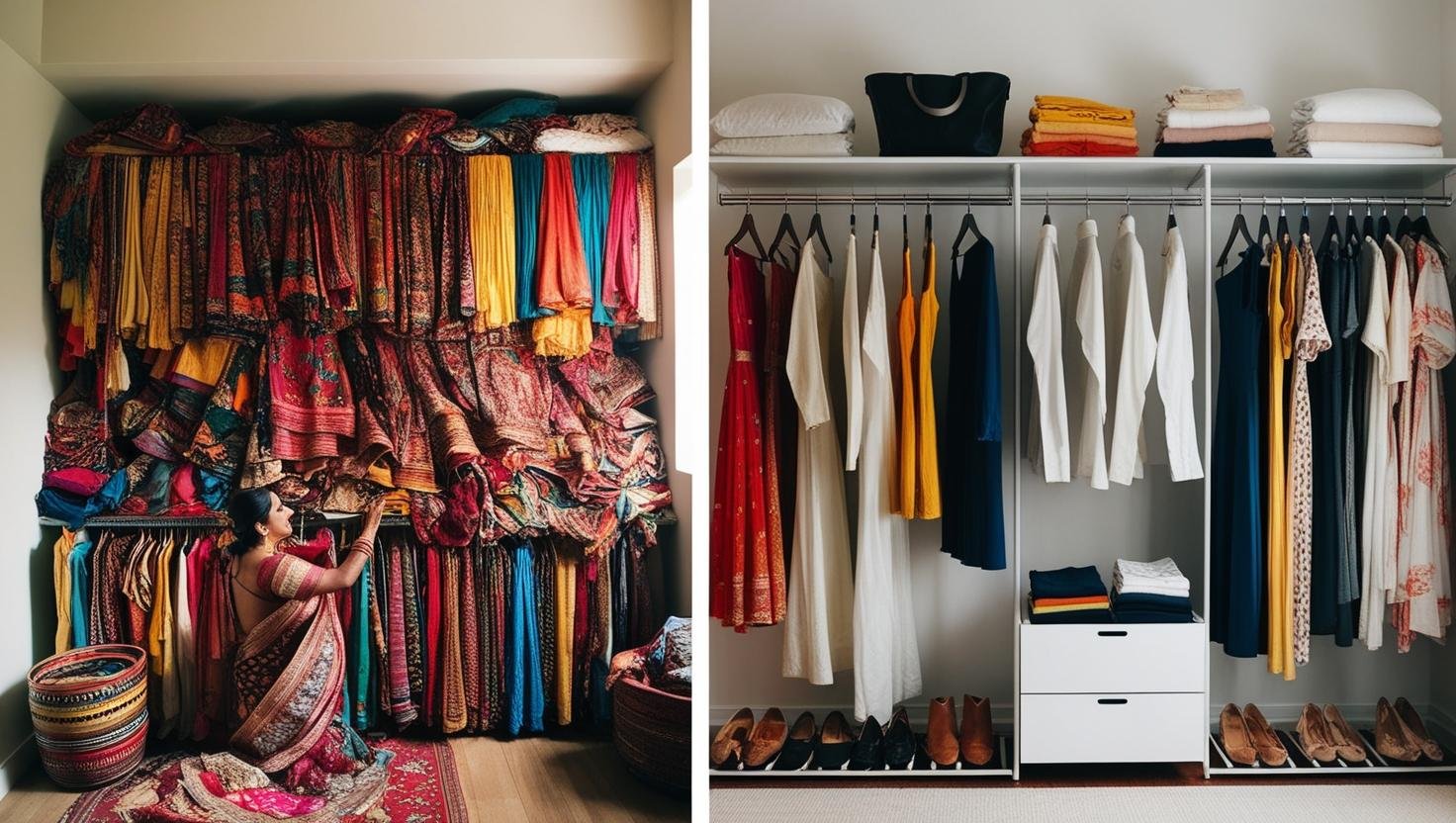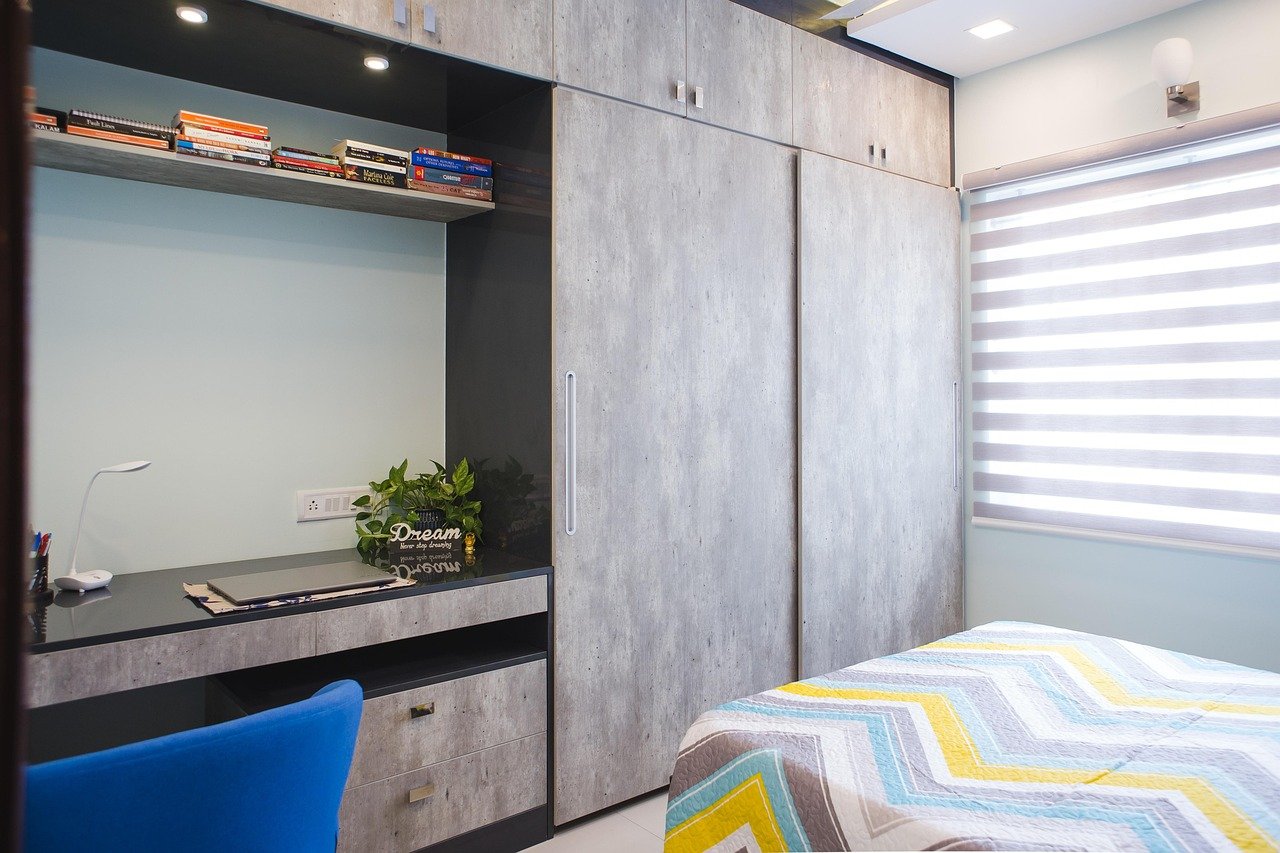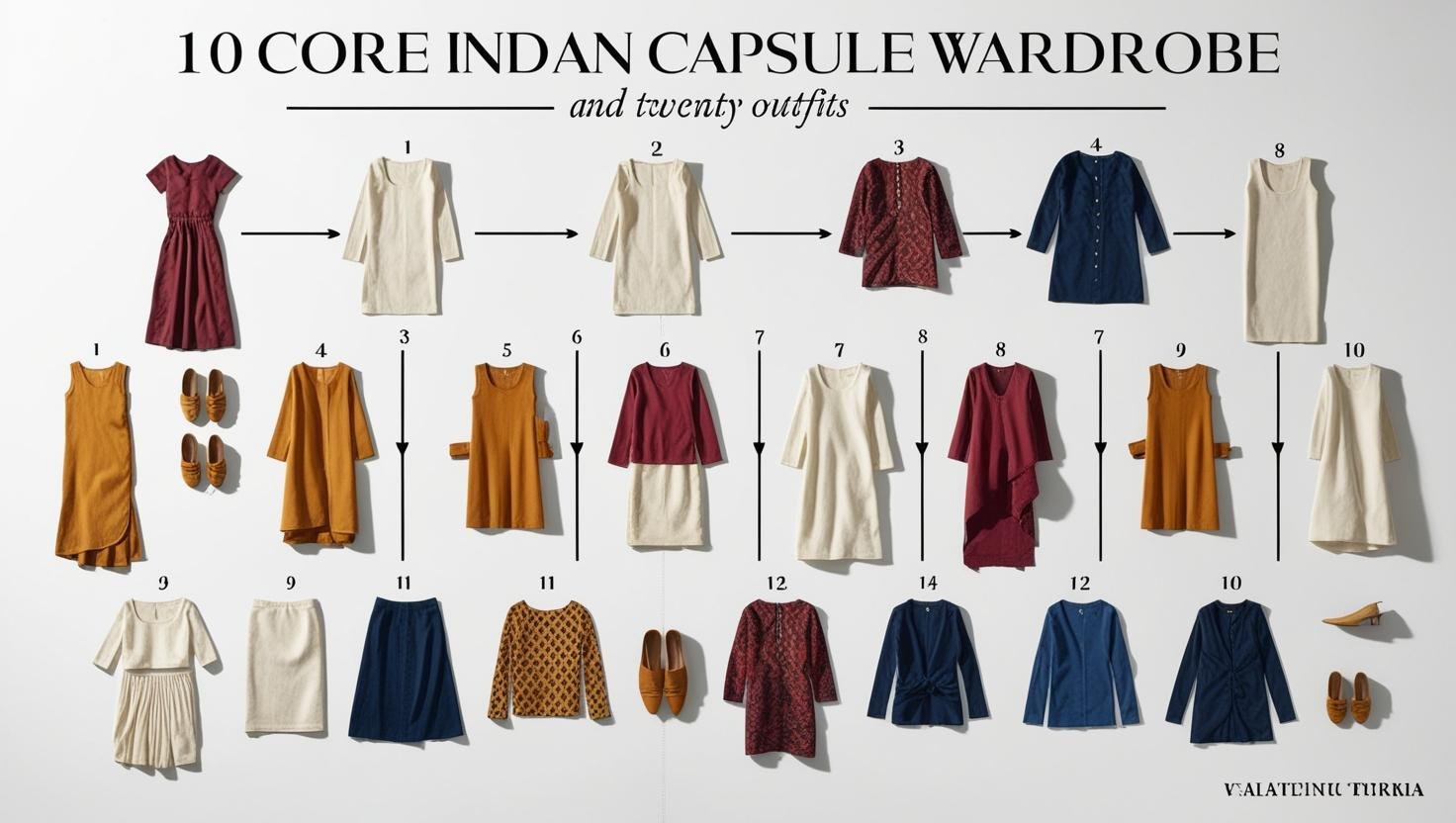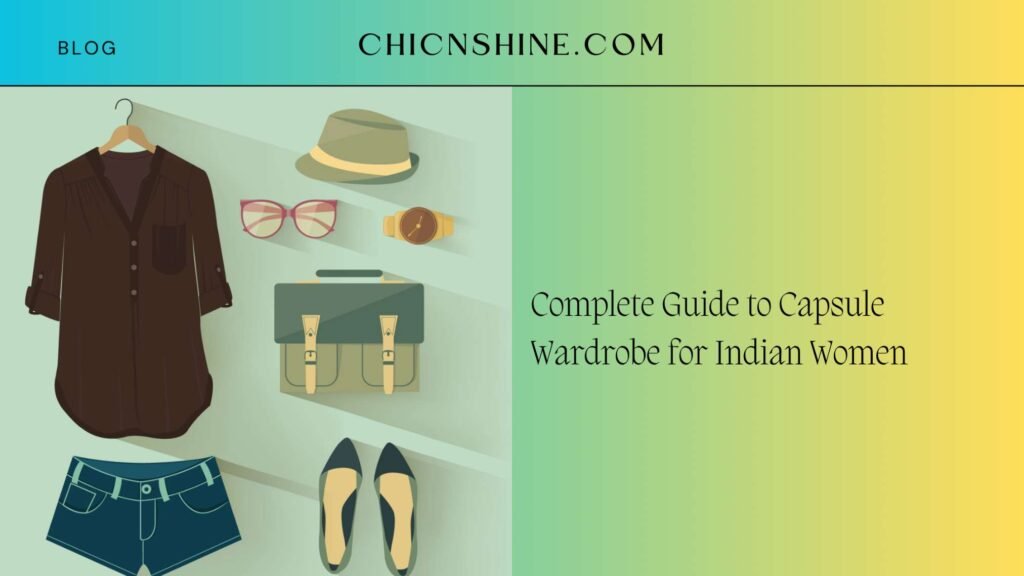When my friend Priya—a Gurgaon corporate lawyer—showed me her overflowing closet (‘But I have nothing to wear!’*), we created a 18-piece capsule that survived 3 monsoons, 2 weddings, and her pregnancy. Here’s the exact India-friendly formula I now teach all my friends.
Building a versatile and practical wardrobe has been a journey of self-discovery for me. As an Indian woman navigating our unique climate, cultural contexts, and fashion sensibilities, I’ve learned that the Western concept of a capsule wardrobe needs thoughtful adaptation. Creating my own capsule wardrobe has transformed how I dress, shop, and express myself through clothing. In this guide, I’ll share everything I’ve learned about creating a capsule wardrobe specifically tailored for Indian women.

What Exactly Is a Capsule Wardrobe?
When I first encountered the concept, I wondered if a capsule wardrobe could work with Indian clothing. A capsule wardrobe consists of a limited selection of versatile, timeless pieces that can be mixed and matched to create numerous outfits. The goal is quality over quantity, with each item serving multiple purposes.
For Indian women, this concept requires special consideration—our wardrobes often span traditional wear, fusion pieces, and Western clothing. The magic happens when we thoughtfully select items that work across these categories, reflecting our multicultural fashion identity.
Why a Capsule Wardrobe Makes Sense for Indian Women
Creating my own capsule wardrobe solved several challenges I faced:
- Climate versatility: With extreme temperature variations across seasons, I needed clothing that could adapt through layering or fabric choices.
- Occasion flexibility: Indian social contexts often require quick transitions between casual, formal, and traditional settings—sometimes all in one day!
- Space constraints: Urban Indian homes typically have limited storage, making a streamlined wardrobe practical.
- Sustainability: By investing in fewer, better-quality pieces, I’ve reduced my environmental impact while supporting ethical Indian craftsmanship.
- Financial wisdom: I’ve saved significantly by avoiding impulse purchases and fast fashion trends.
The beauty of a capsule wardrobe is its efficiency without sacrificing personal style—something particularly valuable in our busy lives.
Foundation Principles for an Indian Capsule Wardrobe
Before listing specific items, I want to share the principles that guide my wardrobe decisions:

1 – Embrace Versatile Silhouettes
I focus on silhouettes that flatter my body type and can be styled multiple ways. For example, a straight-cut kurti works both with leggings for casual settings and with a sharara for festivities.
2 – Prioritize Fabrics Suitable for Indian Climate
Cotton, linen, and lightweight silks are my foundation fabrics—they breathe well in heat but can be layered during cooler months. I consider both comfort and maintenance when selecting materials.
3 – Choose a Cohesive Color Palette
My wardrobe revolves around colors that complement my skin tone and mix well together. I have neutral bases (blacks, whites, beiges) complemented by 2-3 accent colors that reflect my personality while remaining versatile.
4 – Balance Western and Indian Elements
Rather than keeping these as separate wardrobes, I create synergy between them. My palazzo pants work with both kurtis and Western tops; my dupattas double as scarves or stoles with Western outfits.
5 – Quality Over Quantity
I’d rather own five well-made sarees that I love than twenty that barely see the light of day. Quality pieces last longer and often look more elegant regardless of price point.
Essential Components of an Indian Woman’s Capsule Wardrobe
After years of refinement, here’s what forms the core of my versatile Indian capsule wardrobe:

| Category | Key Pieces | Details |
|---|---|---|
| Everyday Indian Wear (8-10) | 3-4 neutral kurtis | White, beige, black |
| 2 statement kurtis | In signature colors | |
| 2 palazzo pants | Black + neutral | |
| 2 leggings/churidars | Black + dark color | |
| 1 straight-cut kurta | Dress up or down | |
| Fusion Elements (5-6) | 2 saree blouses | Doubles as crop tops |
| 1 embroidered jacket | Elevates all outfits | |
| 1 dhoti pants/draped skirt | Casual to formal | |
| 1-2 Indo-western dresses | Fit & flare style | |
| Western Basics (8-10) | 2 jeans | Dark wash + black |
| 2 skirts | A-line/straight, neutral | |
| 3-4 tops | Works with Indian & Western | |
| 1 white shirt | Pairs with sarees/jeans | |
| 1-2 solid dresses | Well-fitted | |
| Occasion Wear (6-8) | 2-3 sarees | 1 neutral + signature colors |
| 1 heavy lehenga | Mix with different blouses | |
| 1-2 anarkali/floor-length kurtas | Elegant styles | |
| 1 formal Western outfit | Dress or separates | |
| 1 versatile blouse | Pairs with sarees/lehengas | |
| Layering (4-5) | 1 neutral blazer | Works with kurtas & tops |
| 1-2 lightweight dupattas | Doubles as scarves | |
| 1 shawl/wrap | For AC/evenings | |
| 1 ethnic jacket/cape | Versatile styling | |
| Accessories | 2 everyday earrings | Gold + silver tones |
| 1 statement necklace | Complements multiple looks | |
| 1 bindi collection | Various styles | |
| 2-3 bangles/bracelets | Matches color palette | |
| 1 classic watch | Timeless piece | |
| Footwear (4-5) | 1 juttis/mojaris | Comfortable ethnic |
| 1 neutral flats | Everyday wear | |
| 1 heels/wedges | Versatile for outfits | |
| 1 kohlapuri sandals | Casual comfort | |
| 1 sneakers | For walking/errands |
Building Your Capsule Wardrobe: My Step-by-Step Process
When I created my capsule wardrobe, I followed these steps:
Step 1: Wardrobe Audit
I removed everything from my closet and categorized items into:
- Love and wear regularly
- Like but rarely wear (examined why)
- Don’t wear or don’t love (donated or repurposed)
This process was eye-opening—I discovered I only regularly wore about 30% of my clothes!
Step 2: Identify Gaps
After selecting my favorites, I identified what was missing for a complete versatile wardrobe. Rather than rushing to fill these gaps, I made a thoughtful shopping list.
Step 3: Define My Personal Style
I created a simple style board identifying colors, silhouettes, and aesthetics that resonated with me. This became my reference when considering new purchases.
How I Mix and Match for Different Occasions
The true test of a capsule wardrobe is its versatility. Here’s how I create different looks from the same core pieces:
| Occasion | Outfit Combination | Key Styling Tips |
|---|---|---|
| Office | Straight kurta + palazzo pants | Add minimal jewelry for polish |
| White shirt + dark jeans + ethnic jacket | Tuck in shirt, add sleek watch | |
| Neutral kurti + black leggings + blazer | Structured bag completes look | |
| Family Gatherings | Saree (change blouse/style) | Experiment with draping styles |
| Dhoti pants + embroidered crop top | Bold earrings elevate look | |
| Anarkali with different dupattas | Change footwear for variety | |
| Festivals | Lehenga skirt + alternate blouses | Try contrasting colors |
| Saree with festive jewelry | Add maang tikka/bangles | |
| Heavy kurta + dupatta + jewelry | Statement pieces shine | |
| Casual Outings | Jeans + kurti + juttis | Roll sleeves for relaxed vibe |
| Palazzo + Western top + ethnic earrings | Half-tuck top for style | |
| Cotton dress + ethnic jacket | Add colorful bangles |
Adapting for Different Body Types and Ages
A capsule wardrobe should celebrate your unique body. I’ve learned to focus on what makes me feel confident:
| Body Type/Age | Flattering Styles | Pro Tips | Avoid |
|---|---|---|---|
| Curvy Figures | Empire-line kurtas | Highlights smallest waist point | Boxy cuts |
| A-line silhouettes | Skims without clinging | Tight fabrics | |
| Strategic dupatta draping | Creates vertical lines | Horizontal prints | |
| Petite Frames | Monochromatic outfits | Elongates silhouette | Oversized patterns |
| Fitted, structured pieces | Maintains proportions | Floor-length overwhelmers | |
| Knee-length hemlines | Balances height | Ankle-length drapes | |
| 20s-30s | Trendy necklines (cold-shoulder, square) | Play with bold colors/prints | Overly mature cuts |
| Experiment with layering | Mix ethnic & Western freely | – | |
| 40s-50s | 3/4 sleeve kurtas | Polished yet comfortable | Sheer fabrics |
| V-neck/V-shaped dupattas | Slimming effect | Cluttered embroidery | |
| 60+ | Classic anarkalis | Timeless elegance | Heavy fabrics |
| Soft cotton/silk fabrics | Breathable & graceful | Unstructured fits |
Sustainable Practices I’ve Incorporated
My journey to a capsule wardrobe aligns perfectly with sustainable fashion:
- I support local artisans and handloom fabrics when possible
- I’ve learned basic alterations to extend the life of beloved pieces
- I organize clothing swaps with friends for items that no longer serve me
- I repurpose old sarees into kurtis, cushion covers, or bags
- I invest in quality over quantity, reducing overall consumption
Capsule Wardrobe Essentials: Where to Buy (2025 India Edition)
| Item | Best Affordable Pick | Price | Why I Love It | Styling Tip |
|---|---|---|---|---|
| White Cotton Kurta | BIBA Plain Kurta | ₹1000 | Washes 50+ times without fading | Tuck into jeans for brunch |
| Neutral Saree | Suta Cotton Silk | ₹3,200 | Pre-stitched pleats save 15 mins | Pair with statement blouse |
| Stretch Palazzo | H&M Wide-Leg | ₹500 | Squat-proof for Indian toilets | Monsoon-proof with kolhapuris |
| Denim Jacket | Zara Dupe | ₹900 | Lighter weight for humid cities | Draped over saree blouse |
| Gold-Tone Jhumkas | Jaipur Earrings | ₹400 | Nickel-free (no rashes!) | Elevates we |
FAQs
How many items should be in an Indian woman's capsule wardrobe?
I find that 35-40 core pieces (excluding accessories and seasonal items) provide sufficient variety while maintaining the benefits of a streamlined wardrobe. However, this number can vary based on your lifestyle—a working professional might need more office-appropriate clothing than someone working from home.
How do I incorporate heirloom pieces or special occasion wear?
Cherished heirloom pieces like special sarees don't need to count toward your capsule limit. Store them properly and bring them out for appropriate occasions. Consider repurposing elements of vintage pieces into more wearable modern items if they're rarely used.
Can I follow fashion trends with a capsule wardrobe?
Absolutely! I add 1-2 trend pieces each season but focus on trends that complement my existing wardrobe. Accessories are also an excellent way to incorporate trends without accumulating too many clothes.
How do I handle wedding season with a capsule wardrobe?
For wedding seasons, I rely on versatility—one lehenga can be styled multiple ways with different blouses, dupattas, and accessories. Borrowing or renting statement pieces for specific functions is also a practical approach I've embraced.


